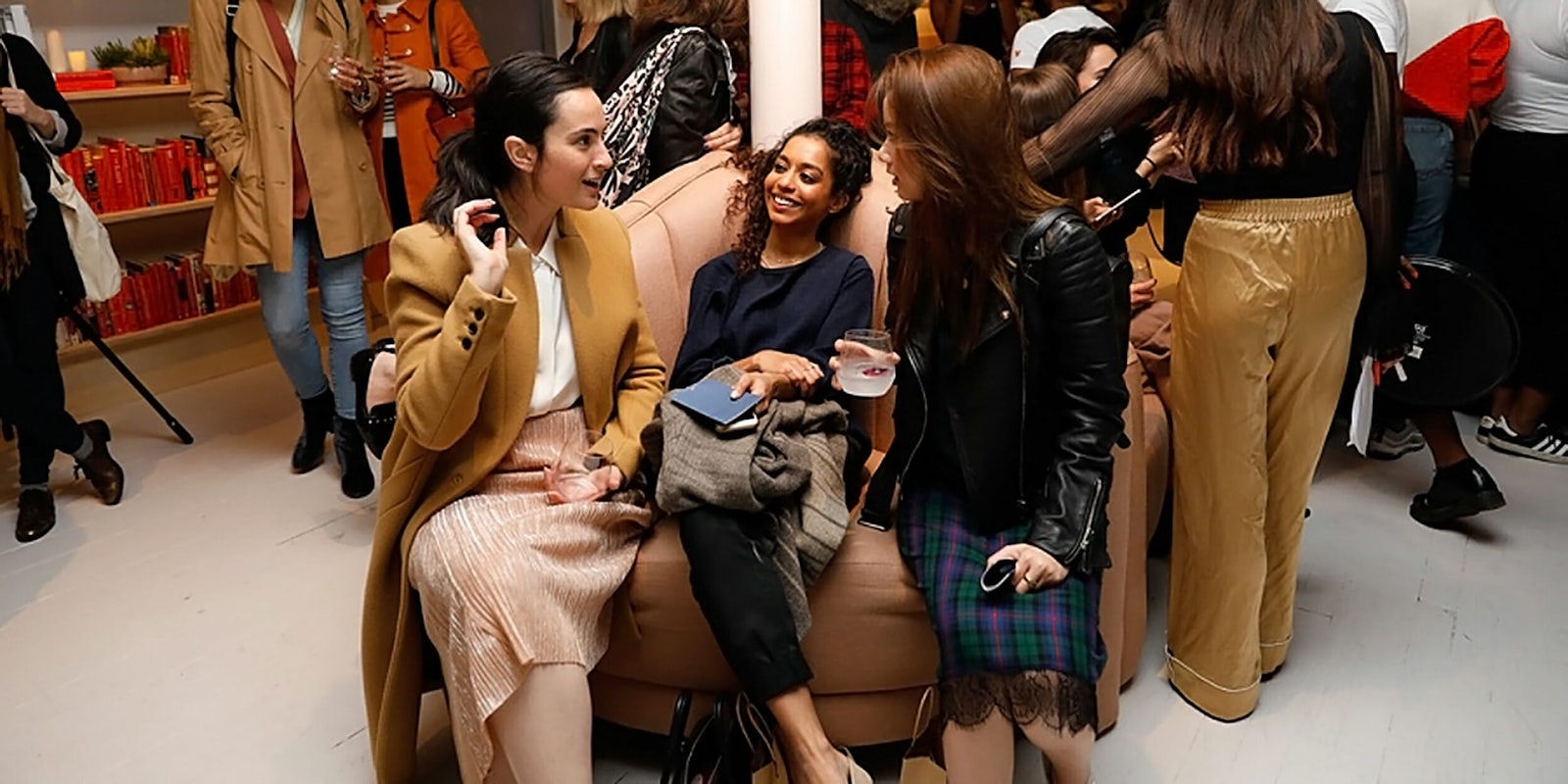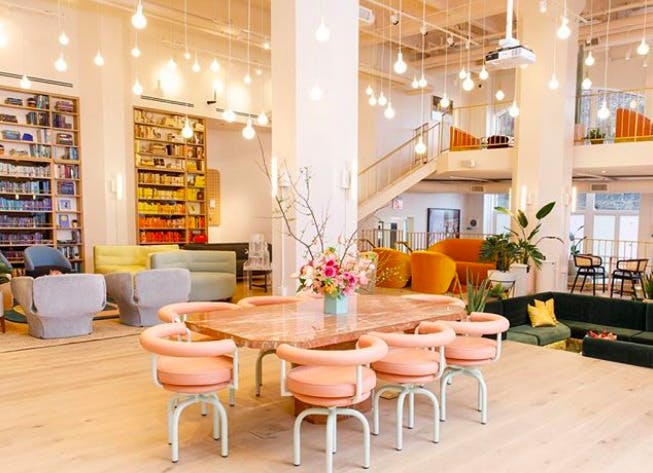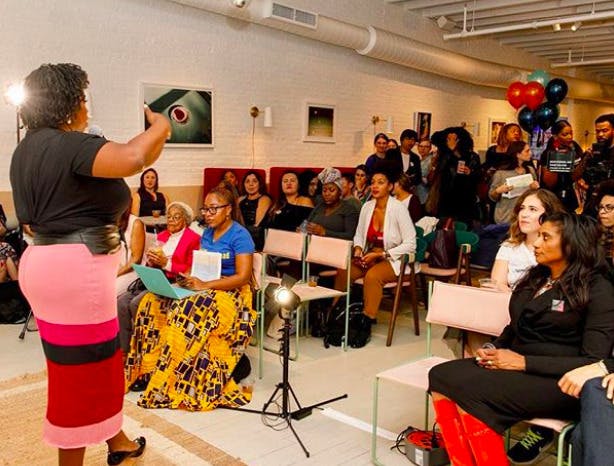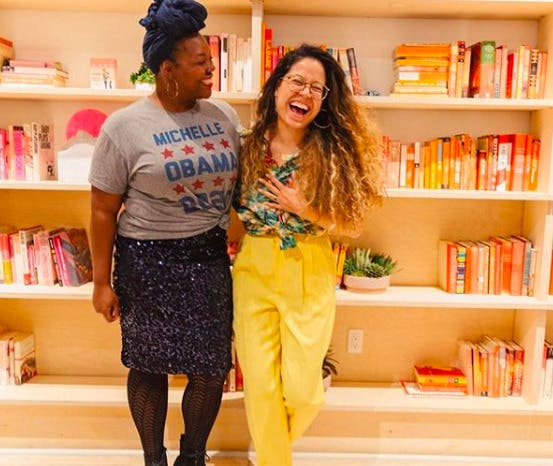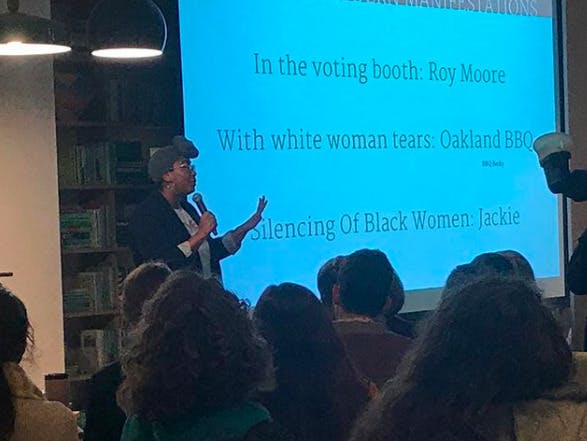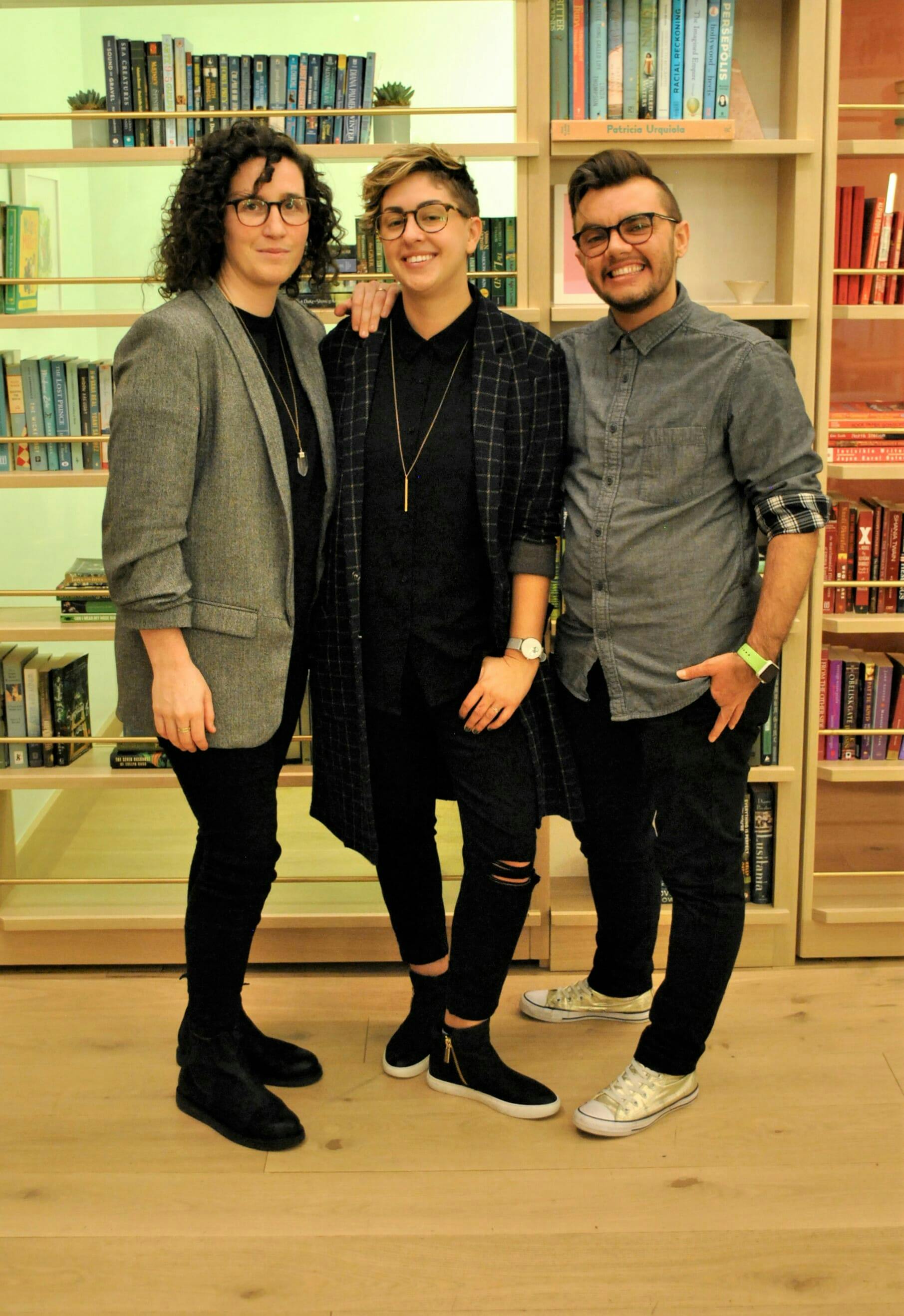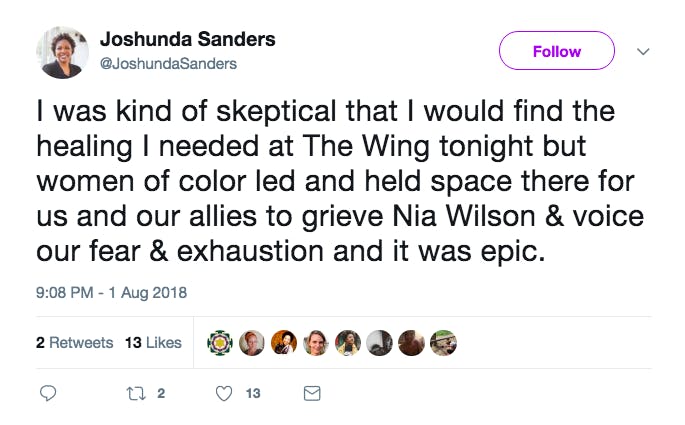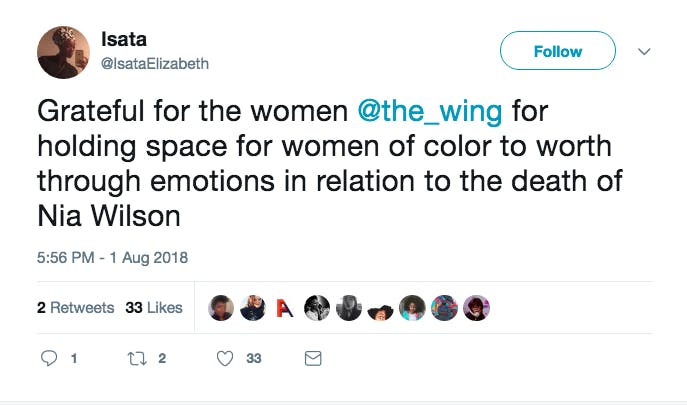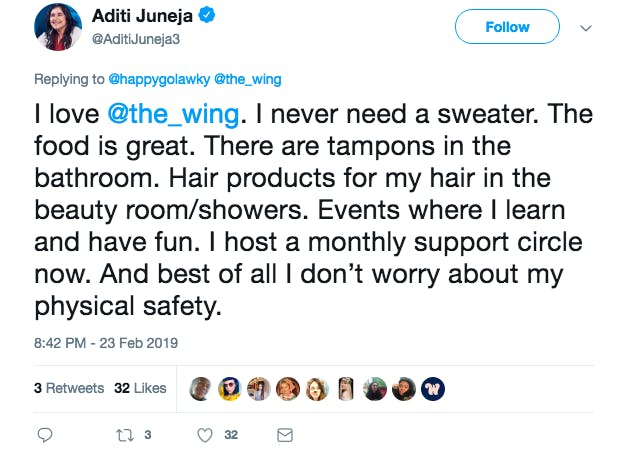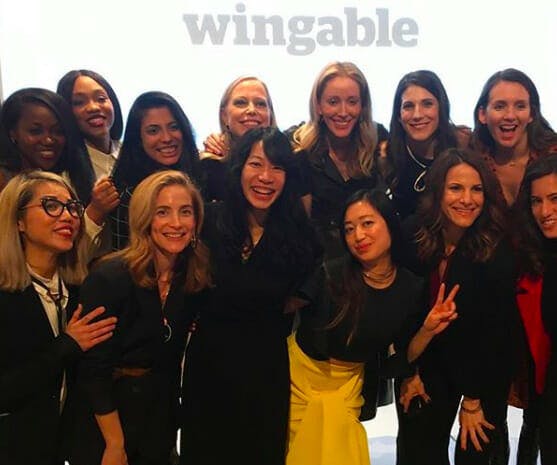“I’m drinking the Kool-Aid,” I whisper to my friend as I sip on a pink drink from the open bar. She nods emphatically as she sinks into one of the Wing’s plush, velvety couches. “I love it here,” she replies. “Can we just live here now?”
I’m a little alarmed by how much I’m enjoying the Wing. The co-working space for women is perhaps best known for its Instagrammable aesthetic; think color-coded bookshelves, staff members in adorable pink sweatshirts, illustrated wallpaper that pays tribute to local female heroes. It has drawn criticism in the past for focusing on advancing a “certain type of woman,” one who can afford the $215 to $250 monthly membership price tag and the compounded costs of money and time in accessing high-end neighborhoods like D.C.’s Georgetown or Brooklyn’s DUMBO. Other critics have noted that the Wing’s privileged “cool girl” founders, Lauren Kassan and Audrey Gelman, have résumés that read like a “[millennial] woman’s greatest hits record” (the latter was the inspiration for the Girls character Marnie) and are, for lack of a better word, “annoying.” And of course, there is a basic skepticism around what this brand is trying to sell us when it preaches feminism wrapped in so much pink.
It’s Election Night 2018, and we are at the Wing Soho’s midterms party hosted by Essence magazine and Higher Heights, a nonprofit that focuses on electing Black women into leadership. I’m here to investigate the Wing’s approach to diversity. But on this particular evening, the Wing feels as “cool” as it does welcoming.
As the election results roll in, the crowd of mostly Brown and Black women mingles in the airy, 10,000-square-foot space. The mood is by turns celebratory and serious. In the larger of two main rooms—with massive factory-style windows, accented with dramatic, leafy plants—a series of panels is being hosted by political strategist L. Joy Williams and includes notable speakers like #MeToo founder Tarana Burke discussing the future of Black women in leadership. In the smaller room, which is connected to the larger one by an open-plan pink café, women lounge and chat while watching the incoming results on a large screen. Occasionally, the room swells with bursts of cheers, as a historic number of women are elected into office. There is also a sense of deflation when Beto O’Rourke loses. When the party runs out of hors d’oeuvres, a huge order of pizza arrives, and smiling Wing staffers circulate the room, offering slices to delighted guests. The vibe is at once cozy and powerful.
I expected the pink cocktails and fancy sofas. But I hadn’t expected that the leaders of the Wing would hand the mic to Black women for the evening. I would never have guessed that an exclusive space would feel this inclusive.
But then I am reminded that the event has been opened up to a larger guest list, including media people like myself who they know will write about the event, and it’s unclear who’s a member and who isn’t. It’s like being invited to a rich, popular girl’s home for a party; it’s easy to wonder if invitations have been made in earnest or as a means to further social gains. Am I witnessing a true shift in the way women in power share their power, or is this a spell that breaks at midnight? Is it all, perhaps, too good to be true?

Since the Wing opened the doors to its Flatiron location in late 2016, it has received no shortage of attention and criticism. In a time when our country, and especially women, have been grappling with what it means to live under a Trump presidency, what and who the Wing is for have been front and center questions.
The Wing has since opened four other locations (Soho and DUMBO in New York, plus D.C. and San Francisco) with plans for spaces in L.A., Boston, Chicago, Seattle, London, and Toronto. Its stated mission is “the professional, civic, social, and economic advancement of women through community.” But critics see the Wing as a luxury space focused more on superficial perks than on civic advancement. And upon visiting, it’s easy to see why aesthetics would be your initial takeaway. Each Wing space is as meticulously thought-out as a bridal shower thrown by your most doting, type-A friend—aggressively pleasing to look at and filled with cheeky flourishes that say, “Hey, we’re fun!”
But most of all, critics have repeatedly voiced skepticism that the Wing is just another form of branded feminism that seems designed for those who are already well-advantaged and well-connected. And it’s a fair point: The problem with building a luxury feminist space with membership dues is that it attracts the powerful and privileged first. While these women can see the ways in which they’ve been discriminated against, they can fail to recognize the urgent need for intersectionality and the myriad reasons marginalized people haven’t had access and have been kept out of such spaces historically and presently. By seeking their own advancement, these privileged, often white women risk creating new elite groups that only reinforce the very patriarchal systems of power that feminism seeks to reform. In other words, when you pair a luxe Manhattan loft with the idea of women’s empowerment, you create a slippery slope.
But in the two and a half years since the Wing opened, the owners and management have tried to make that path less slippery. The Wing has heard the criticisms and has made the concerted effort to focus on diversity. You could argue this focus is reactionary PR to being called out. But what has changed at the Wing goes beyond a brand taking steps to look good for its nearly 350,000 Instagram followers. The majority of what you’ll see in terms of inclusion, not just in membership (6,000 members and growing) but in programming and policy changes, has been developed based on actual feedback from members themselves. The people who are shaping diversity at the Wing have a vested interest in what they’re doing because they themselves are the very women of color and trans and nonbinary people whom the Wing might otherwise fail to serve.
“We love feedback,” Yari Blanco, the Wing’s senior manager of culture and diversity, told the Daily Dot. “We take feedback really seriously here.”
Perhaps the most illuminating example of member feedback leading to company change is that Blanco herself was hired when, after six months of membership, she pitched the role she now holds to the Wing’s founders. Blanco said she loved her experience as a member, but felt she could have a meaningful impact in a leadership role. “I felt like why not pitch the thing that I want to do that affects the bottom line and that I also feel is the right thing to do?” she said.
According to Blanco, Gelman and Kassan responded enthusiastically. In August 2017, she became the Wing’s eighth employee. A quick glance at the Wing’s top staff reveals that its founders have hired a number of other women of color into leadership roles. Several of the Wing’s community managers are women of color, and the CFO, Diedra Nelson, is a Black woman, something unfortunately rare in the world of tech and startups.
The Wing also partners with organizations that help to employ formerly incarcerated women and survivors of domestic abuse; these women make up 20 percent of the staff at the Wing DUMBO.
Since her hiring, Blanco has expanded the diversity of the Wing’s programming, with a focus on events that partner with businesses and organizations led by women of color. According to Blanco, past events have included companies such as Slant’d, a magazine that celebrates Asian-American identity; Well Read Black Girl, a book club turned literary festival; Broccoli City, a POC-owned music festival in D.C.; and Women Sound Off in San Francisco. Activist and lecturer Rachel Cargle has also given her signature lecture “Unpacking White Feminism,” at the Wing in both New York and San Francisco, to great attendance.
But Blanco’s impact goes beyond the event level. There are also everyday cues that let members know their needs have been considered. “[We’re] ensuring that there is diversity and inclusion down to the products that we use in the beauty room,” Blanco said. Since its opening, the Wing has stocked toiletries from brands like Carol’s Daughter that focus specifically on styling products and creams for Black hair, and members can now book Black hair-styling services and receive them in the beauty room, which is stocked with complimentary grooming products. There are also showers with robes and slippers, storage lockers, and a pumping room for breastfeeding mothers.
“It feels really supportive,” said Liana*, who has been a member of the Wing for over a year. “It feels as though the people that are making decisions are not so dissimilar from me.”
Liana also expressed that some of the most affirming moments she’s experienced at the Wing have come from the simplest of interactions. Liana recalled working alongside two other Black women at the Wing DUMBO and being delighted to casually discover, after hearing one of the women speaking on the phone, that they shared a background in tech. She said, “I came to realize…[she] was close to my line of work because she was talking about these technical structures that I understood and I’ve never heard another Black woman talk about that at all. And it was just so amazing to have that in my ear. That was so satisfying.”
To receive IRL feedback, Blanco also holds office hours twice a month, for two hours at a time at each of the NYC locations. Office hours are also held in D.C. and San Francisco, where community managers make themselves available. Additionally, Blanco said she makes an effort to introduce herself to members at events, as she sees member insight as a crucial piece of continuing to build diversity at the Wing. Then there are the feedback boxes at various Wing locations, labeled “insert feels here,” where members and their guests can voice concerns. Frequently, Blanco said, members also email Gelman directly, as she did, with their questions and issues. “We’re constantly trying to improve, and every day we’re striving to do the best that we can with the resources we have, and always while centering the voices of our members, especially those who are marginalized,” said Blanco.
Zara Rahim, the Wing’s communications director, who was formerly the communications director for Vogue, echoed Blanco’s sentiments. When it comes to diversity, she said, “Unless you are fully intentional about it, you can’t do it. Diversity is not possible if it’s left to chance.”
In fact, in response to member concerns, the Wing made perhaps its most monumental change yet in January. In an email to members, the founders announced that they had changed the pronouns they used to describe members from “she/her” to “they/them” to be more inclusive of trans and non-binary people. Guest emails now read “They’ve Landed” instead of “She’s Landed.” Members are now gender-neutral Winglets as opposed to Wing Women.
Max Masure, who came to the Wing DUMBO in September upon receiving a scholarship, said the change has been incredibly meaningful for not only them, but for the visiting guests they receive for meetings at the Wing. “Many of my guests are nonbinary and I can see in their faces when they see they/them in the email they feel that ‘I’m welcome here. I don’t have to pretend. I can actually be me.’”
Masure said they initially thought that the Wing wasn’t a space for them since they identify as nonbinary. But when they heard that the Wing’s pilot scholarship program was open to trans and nonbinary applicants, they applied and were pleasantly surprised to receive one. “I thought, ‘Wow, they care about bringing some nonbinary people in. It wasn’t just a marketing move!’” they said.
Shortly after arriving at the DUMBO location in September, Masure, whose company Argo Collective specializes in gender-inclusion training, offered to lead a gender-inclusion workshop for members and staff. “They said yes immediately. They were like, ‘This is why we want you to be here! We want to be inclusive and we want to learn.’”
Masure said their experience at the Wing stands in contrast to their experiences working with other companies. “A lot of [companies], it’s like, ‘Oh, we’d really like to, but we can’t do that.’ But with them it’s ‘Yes! When?’”
The Wing also recently formalized and expanded its scholarship program that brought in members like Masure. Previously limited to its DUMBO and San Francisco locations, scholarships will now be available at all of the Wing’s locations, with 100 free two-year memberships (which would typically cost $4,700) available at each site. In January, the Little Wing, a childcare space, launched at the Wing Soho. The space offers members two-hour babysitting sessions for $25. It’s also open for “open play” for members and their families on weekend mornings at no additional cost, and the Wing’s employees are welcome to use the space for their own childcare, free of charge. The Wing plans to open a second Little Wing in L.A.
There seems to be a pattern of what makes diversity successful at the Wing: Members feel safe sharing ideas and offering services that could potentially transform the space. And when they do, it appears those offers have been met with enthusiastic action.
READ MORE:
- White feminism is fertile ground for white nationalism
- A guide to understanding cisgender privilege
- Everything you have never understood about being nonbinary
However, Tuya*, an East Asian member, cautioned that the Wing is no utopia. “Asian erasure is real,” she said. “I think it’s generally a pipeline problem, and it’s not just related to this place. [But] when we talk about diversity [at the Wing], the focus is on Black and Brown women. We don’t talk about orientalism.”
Tuya said that she has spoken up about Asian erasure at events, but the crowd did not seem to share her concerns. “It was like crickets,” she said. Tuya also described interactions with white members who failed to notice her expertise or talk over her. She said, “One woman was looking for investments for her film fund initiative. Me and my Black friend were in a large group and we mentioned what we knew about VC (venture capital) and she kind of looked at us like we couldn’t possibly know what she was talking about.”
Similarly, in the process of amplifying the most marginalized voices, the Wing has been accused of missteps. In late February, the Wing hosted a panel discussion on “Unpacking Sex Work Stigma and Intersectionality.” The event was curated by SX Noir, a Wing member who had formerly called out Ashley Judd for her stance on sex work at another Wing event. While the panel enjoyed great attendance, there were grievances regarding payment for both panelists and the moderator. The Wing has since shared on social media that they were in conversation with SX Noir and would ensure that all panelists were compensated for their time.
https://www.instagram.com/p/BuuKwCBAzYD/
SX Noir told the Daily Dot that while she and the Wing have reached an agreement regarding compensation, she’s disappointed by how the situation was handled. “There needs to be more transparency about the funding that goes to panelists and how that’s being allocated,” she said. “When we’re dealing with marginalized voices we have to take extra effort and be more mindful. It takes more work.”
Some of the Wing’s design choices have also drawn criticism for issues of tone-deafness. Last fall, for example, when the Wing debuted a Christine Blasey Ford conference room, following Brett Kavanaugh’s SCOTUS confirmation hearings, some on social media expressed discomfort and disdain. They felt it was exploitative and an attempt to cash in on what had been a deeply painful collective moment for so many, as Ford testified in detail about being sexually assaulted as a teen. The Wing responded on social media that it had, in fact, gotten Dr. Ford’s blessing. Rahim confirmed that they had reached out to Ford and her team directly and that the intention of the space was to honor her and her bravery. “If members had reached out to me to say this was upsetting or triggering, we would have done something,” said Blanco.
Despite occasional misfires, Tuya said she otherwise enjoys her membership at the Wing, so she’ll continue to be vocal about the microaggressions that do upset her. “Even people who are very resistant to hearing me out when it comes to this kind of stuff,” she said, “it seems like they at least want to listen.”
A willingness to listen could also be thanks to the proactive social contract that Blanco implements for discussions and events. “It’s about setting people up for success,” said Blanco, who co-created the contract with the Wing member Eboni Marshall Turman, who is a professor of theology and African-American religion at Yale University.
The Wing’s social contract includes bullet points that hold those attending events accountable to treat one another with respect, and it encourages them to use “I statements” and be “active listeners.” Members and guests are also informed that the point of dialogues is not to reach consensus, but rather to “reach higher levels of understanding by examining different opinions.”
According to Blanco, the social contract is essential to “setting people up for success.” For example, when Black teen Nia Wilson was murdered in Oakland last fall, Blanco hosted a support circle in New York and decided to open the event to the public. Allies were told they were welcome to attend and support the event, but, in addition to the social contract, Blanco gave precise instructions—this was not a time for them to speak up. Instead, they were asked to step back and listen to the women of color who attended the event.
“We always give rules of engagement,” said Blanco. “[We’re] allowing people to share their truths without having anyone walking away to feel like they were personally persecuted.”
In response to member feedback about the need for more events addressing the needs of members with disabilities, the Wing DUMBO now holds a monthly support circle for those living with invisible illnesses.
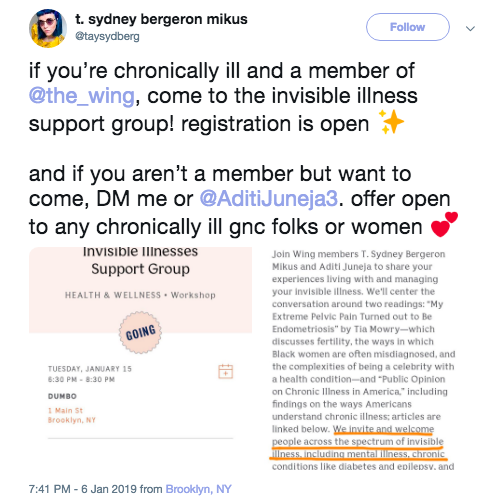
The support circle, like other events at the Wing, is an example of times when the Wing opens its doors to non-members, turning the notion that it’s a space for a select few on its head. While it’s exciting to see that the people running the Wing are open to extending its resources, especially its capacity to gather and connect those who are seeking support, it’s unclear how anyone would find these opportunities without already knowing someone who’s involved with the event, or at least knowing a member. Not every socio-economic group, professional field, or neighborhood enclave is familiar with the Wing. It’s another issue of access.

In terms of building diversity, it seems that the Wing’s attention to detail has led to success. But in other instances, the Wing’s meticulousness can make members feel stifled. For example, members are not allowed to consume outside food, forcing them to buy meals and snacks from the Perch, the Wing’s historically overpriced coffee and food bar. “Sometimes, someone at the roof space in Flatiron will like, sneak a carrot stick,” Molly*, a member told the Daily Dot. “I’ve seen people get a bowl from the Perch and dump their Sweetgreen salad in it,” she added.
Liana noted that the Perch has improved its pricing options—you can now purchase a half a sandwich and a salad for $7. But, still, for some who are scraping together the more than $200 per month membership fee, the cost, paired with the rules against outside food, can feel prohibitive. It can also create feelings of a lack of class-consciousness.
Molly said that she originally imagined, based on the Wing’s upscale image, that it was out of her budget. But she had been paying for a simple co-working space elsewhere in Brooklyn, and when she realized the pricing was similar, she applied. She had attended a women’s college and said she saw joining the Wing as a natural extension of that experience. “It’s like being at [my college] library,” she said.
Except that at the Wing, Molly said she doesn’t feel she can dress as casually as she did in college. The Wing has no formal dress code, and Molly said it was obvious to her that she was welcome to wear whatever she wanted to the space, but she felt a certain pressure to dress up for the Wing. She said, “People do dress nicely here, and my sister, who was just born in athleisure, she always feels like a little out of place.” She added, “[When I come to the Wing,] I do challenge myself to step it up a little bit in terms of my looks.”
READ MORE:
- Audrey Kitching is a Myspace queen turned energy healer. Critics say she’s also a fraud
- The makeup revolution is being led by queer influencers of color
- Adjusting to America: What happened to the migrant girl whose cries shook the country
Ventrice Lam, a product consultant, who has had an all-access membership since the Wing opened its Soho location in 2017, said that she has seen a change in the way members dress at the Wing. “A year ago, the Soho location was very high fashion, and it made some of my guests who’d come in in jeans and T-shirt uncomfortable. But now you see people who are more comfortably dressed.”
Lam said she was initially skeptical of the Wing’s aesthetic. She had visited the Wing’s Flatiron location for a coffee date and didn’t necessarily feel it was the right space for her. “My first impression was that it was just very, very pink. I’m not a girly girl, and I didn’t feel comfortable.”
But, eager to meet other female entrepreneurs, Lam decided to go into the Wing with a utilitarian sense of purpose: to make useful connections for her inclusive design company, Bedelia. In a serendipitous moment in the Wing’s elevator, she encountered fellow Wing member Bea Arthur, a woman who had inspired her to leave her full-time job years earlier when she spoke at a Women 2.0 event. The two ended up collaborating together.
Lam once even invited her husband to the Wing for a casual visit and was amused by his reaction. “He was like, ‘Wow. I did not feel unwelcome, but never before have I felt so much that a space was not designed for me.’ And I was like, ‘Well, welcome to being a woman.’”
To Lam, the perks of working at the Wing now feel indispensable, especially the free lip balm and baskets of blankets. “As a woman who constantly has dry lips and is constantly cold, those are two things that I need.”
Lam’s comments point to a theme that came up again and again at the Wing: It’s a space where things can feel idealized or overly perfect, but it’s also one that provides a rare experience for women. At its worst, the Wing can leave you feeling small, plain, and less than worthy. But at its best, it can make you feel deeply cared for, respected, and empowered. For all the criticism of the Wing as an elite space, perhaps what it’s selling us is the radical notion that women and nonbinary folks deserve to be treated with the kind of thoughtful attention that’s frequently reserved for men.
When I visited the DUMBO location, I felt both the empowerment and pressure that people described. It could feel, at times, like an insular pink bubble floating on the periphery of the grittier reality of Brooklyn, where the unpleasant facts of class inequity are easily witnessed. The Wing is perhaps jarring because it’s so intentionally pleasant that being there might remind you, by contrast, of all the ways the outside world is so upsetting.
And yet, there is something deeply hopeful, intoxicating even, about being in the space. It felt good to be in an airy quiet room with gorgeous views of the Brooklyn Bridge, surrounded by beautiful people tapping away at their laptops. Occasionally, they paused to exchange smiles and conversation. This was much better than working from home, alone, in my apartment, or at an unpredictable, noisy café. I admired the views of the East River and Manhattan from my seat and sighed. The Wing’s DUMBO location is in a space that was formerly occupied by Bubby’s, a restaurant where, years ago, I had enjoyed coming on weekends to splurge for a $30 brunch, which, ironically, I’m aware was its own privilege, but one that still feels more accessible than the Wing.
Moments later, I noticed a Latinx cleaning person carefully dusting a shelf filled with orange and yellow books, while a white woman with perfectly arranged corkscrew curls pulled the bookcase open to reveal a hidden cubicle. I was snapped back to Earth.
On the one hand, the space was enchantingly colorful and full of secret promise. On the other, I could not help but be reminded—as this immaculate white woman opened a literal door to a secret world—that that promise, and the means to access it, is still reserved for a select few.

On a Thursday evening in late January, I returned to the Wing Soho for Wingable, an event hosted by _able, a woman-owned investment fund. Ten finalists pitched their startups to a large crowd of guests and investors. The presenters were diverse in ethnicity and age and the products and services on offer ranged from dropship luxury hair extensions to community-fueled solar power. One presenter high-fived another as she left the stage. When a technical difficulty interrupted one of the final presentations, the presenter took it in stride, laughed it off, and the crowd cheered her on. The mood was jubilant, and, with $500,000 of guaranteed funding from _able in play, there was a heightened feeling of possibility. Should I, too, I wondered briefly, start a company?
As I waited on the dingy Canal Street platform for my train home, I chewed on a bit of high-fiber seaweed jerky from the gift tote I’d received. It was savory but stale. I responded to a group text with girlfriends, “Everything in this tote is high in fiber.” Thinking of my own possible startup I added, “The future is bathrooms.”
The Wing is trying to grow the improbable—an exclusive space that feels inclusive. How included you feel may depend upon a number of factors: how much you like to play dress up, for one, and perhaps more importantly, whether or not you already have a “cool” job, or the financial means necessary to take big career risks. If you’re privileged enough to enjoy an entrepreneur lifestyle and still have money in the bank to treat yourself to a $15 glass of rosé from the Perch, you might enjoy the Wing without being interrupted by the moments of aspirational dread that visited me as I worked from the Wing DUMBO. But when it comes to diversity with regards to gender and color, while microaggressions certainly haven’t been eliminated from the space, the Wing has shown that it’s dedicated to making its members feel welcome and heard.
The overall feeling expressed by member after member was one of feeling authentically supported and cared for. Lam said, “I think the thing about the Wing is they’re always trying their best, and you can feel that from the leadership all the way down to the women pouring your coffee. They’ve curated a group of people who are working really hard in their fields, and that contributes to the overall atmosphere.”
When I asked Masure if there are areas where the Wing can improve, they told me, “I don’t think it’s ever done. People working in diversity inclusion will always tell you that it’s never done. You always have to go back to the people you are caring for and ask them how they feel. It’s never-ending work.”
It’s worthwhile to look at the Wing through a critical lens. Certainly, there are ways that it can improve, and, as Masure points out, if they wish to serve marginalized groups they will always need to ask themselves how they can do better. But some criticisms of the Wing also highlight the endless perfectionism that successful and ambitious women encounter. Would WeWork’s billionaire co-founders, for example, ever be held to such scrutiny?
It is hard to be hopeful when it comes to progress. In part, because calling in and calling out is necessary to keep safe spaces safe. But let’s dare to be hopeful that, as the Wing expands its members, and as critics keep speaking up, its leaders will keep listening.
*Some names have been changed for anonymity.

